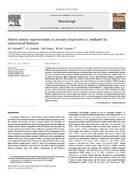Use este identificador para citar ou linkar para este item:
https://repositorio.ufrn.br/handle/123456789/23122Registro completo de metadados
| Campo DC | Valor | Idioma |
|---|---|---|
| dc.contributor.author | Schmidt, Kerstin Erika | - |
| dc.contributor.author | Lomber, S.G. | - |
| dc.contributor.author | Payne, B.R. | - |
| dc.contributor.author | Galuske, R.A.W. | - |
| dc.date.accessioned | 2017-05-26T15:01:23Z | - |
| dc.date.available | 2017-05-26T15:01:23Z | - |
| dc.date.issued | 2011 | - |
| dc.identifier.issn | 1053-8119 | - |
| dc.identifier.uri | https://repositorio.ufrn.br/jspui/handle/123456789/23122 | - |
| dc.language | eng | pt_BR |
| dc.rights | Acesso Aberto | pt_BR |
| dc.subject | Pattern motion representation | pt_BR |
| dc.subject | primary visual cortex | pt_BR |
| dc.subject | transcortical feedback | pt_BR |
| dc.title | Pattern motion representation in primary visual cortex is mediated by transcortical feedback | pt_BR |
| dc.type | article | pt_BR |
| dc.description.resumo | A highly important question in visual neuroscience is to identify where in the visual system information from different processing channels is integrated to form the complex scenery we perceive. A common view to this question is that information is processed hierarchically because small and selective receptive fields in lower visual areas melt into larger receptive fields in specialized higher visual areas. However, a higher order area in which all incoming signals ultimately converge has not yet been identified. Rather, modulation of subthreshold influences from outside the classical receptive field related to contextual integration occurs already in early visual areas. So far it is unclear how these influences are mediated (Gilbert, 1998; Angelucci and Bullier, 2003; Gilbert and Sigman, 2007). In the present study, we show that feedback connections from a higher motion processing area critically influence the integration of subthreshold global motion cues in early visual areas. Global motion cues are theoretically not discernible for a local motion detector in V1, however, imprints of pattern motion have been observed in this area (Guo et al., 2004; Schmidt et al., 2006). By combining reversible thermal deactivation and optical imaging of intrinsic signals we demonstrate that feedback signals from the posteromedial suprasylvian sulcus are critical for the discrimination between global and local motions already in early visual areas. These results suggest that global features of the visual scenery are fed back to lower visual processing units in order to facilitate the integration of local cues into a global construct. | pt_BR |
| Aparece nas coleções: | ICe - Artigos publicados em periódicos | |
Arquivos associados a este item:
| Arquivo | Descrição | Tamanho | Formato | |
|---|---|---|---|---|
| Pattern motion representation.pdf | Artigo completo | 2,7 MB | Adobe PDF |  Visualizar/Abrir |
Os itens no repositório estão protegidos por copyright, com todos os direitos reservados, salvo quando é indicado o contrário.

